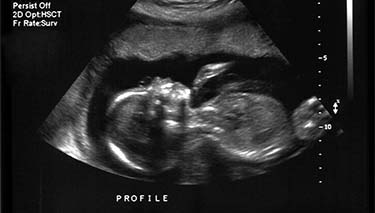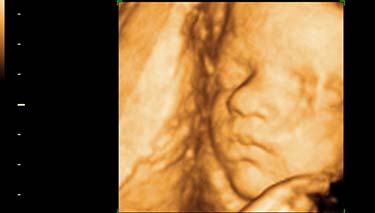What exactly is an ultrasound?
All types of ultrasound are a medical procedure which is otherwise known as a scan. This involves high frequency sound waves transmitted through the body and then picked up on a screen.
During pregnancy, a device known as a transducer is used to move along the mother's abdomen and this sends sound waves via her abdomen and through her uterus. These sound waves bounce off the baby in the form of echoes. A computer picks up the echo messages and translates them onto a screen. As the baby moves and kicks, images can be seen on the ultrasound screen. These sound waves are very high in pitch and intensity and cannot be heard by the human ear.
Ultrasound is a painless and non invasive procedure. However, as you may need to have a full bladder if you are in the early stages of your pregnancy, it can be a little uncomfortable.
What's the difference between a 3D and 4D ultrasound?
4D or 4 dimensional scans build on the technology of 3D scans. The extra dimension is time, so that effectively 4D ultrasounds are moving images of your baby in real time. As your baby kicks, moves, frowns, grimaces, sucks their thumb, opens their eyes and moves their lips, you will be able to see these movements on the scan as they are actually happening.
The technology associated with 4D ultrasounds makes them more expensive and they are not generally offered as part of a routine obstetric service. If parents choose to have a 4D ultrasound done, they will need to pay for this procedure themselves. If it is done in a medically aligned sonography practice, Medicare may rebate some of the fee. Alternately, some private health insurance companies could provide a rebate. Check with your individual provider.
3D Ultrasounds are also known as elective prenatal ultrasounds. They are not designed to replace the standard 2D procedure which is commonplace obstetric procedure. Instead they offer a more enhanced bonding experience with the unborn baby and are instigated by parents choosing to have them done, rather than a medical need.
Some parents are very keen to see for themselves how their baby is growing and developing, and for this reason another name for the 4D ultrasound is a lifestyle scan.
Important information
Both 3D and 4D ultrasounds are not designed to replace a standard obstetric ultrasound. Many companies will not do a 3D or 4D ultrasound unless a 2D medical diagnostic ultrasound has been done first. This is to screen out any abnormalities for both the mother and her baby.
Mothers also need to be engaged with a pregnancy healthcare provider first before having a 3D or 4D ultrasound.
How much will a 4D ultrasound cost?
If you go to a sonography clinic which is medically run then you will be able to make a Medicare claim on at least a portion of the fee.
But if you go to a clinic which does not provide medical screening, e.g. those which do not claim to be diagnostic and are instead entertainment , then you will need to pay all costs and won t be able to get a Medicare refund. Ask questions about the training and expertise of the staff who are doing the scan.
Since technology has expanded and 3D/4D scans have become readily available, there is a lot of competition in the market. Different clinics claim to provide superior and more enhanced images and their advertisements can be very enticing.
At the non-diagnostic clinics, packages range in cost from around $100-$200 depending on what level of service you want. You can get a DVD with or without music of your choice, image print-offs and a CD of the images.
Some practices have special discounted prices, when couples make appointments for more than one 4D ultrasound session. Ideally, these are some months apart. For couples who are keen to gauge the individual growth and development of their little baby, these 4D ultrasounds can be fascinating.
When should I have my 4D ultrasound?
There is some discrepancy between clinics around when a 3D and/or 4D ultrasound should be done. Many claim the optimum time is somewhere between 27-32 weeks of gestation and others state between 26- 30 weeks. On either side of these time frames a three week window will still provide a good viewing alternative.
From 19-24 weeks of gestation, gender determination scans can be done. At this early stage though, the baby does not have enough fat to fill out its facial features, so the quality of the scan and images you ll see won t be as clear as they will be later. Waiting for just a little longer and being patient will reap a lot of benefits!
Last Published* May, 2024
*Please note that the published date may not be the same as the date that the content was created and that information above may have changed since.

















